Clematis have been considered unique decorative plants for a long time, which not only have a number of incredible features of the appearance, but also are simply a huge amount of species and varieties. All these varieties are widely used in gardening and each landscape designer seeks to decorate the plot of Clematis of an unusual and spectacular variety.
Clematis Louise Row is a bright representative of the large-flowered variety of culture, which will undoubtedly become a central decoration of any site. Its large terry, semi-world or simple lilac flowers, blooming simultaneously on shoots, will throw a glance and make it becomes even the most distant people from the colors of people. Clematis Louise Row, landing and care for which no difference from most varieties of this culture will help create incredible garden compositions.
To admire the incredible flowering of Clematis of this variety, in this article we consider the features and description of Clematis Louise Row, as well as we describe the main options for its use in landscape design. We note the main rules and nuances of planting and care for a curly decorative culture.
Features and morphological description Clematis Louise Row
Clematis Louise Row is a long-term, compact, repeated liano, which belongs to the genus Clematis or Lomonosos and the ottikovy family. This early large-flowered variety of climbing Lianov was bred in the UK in 1983 by scientist Botany Jean Row. In honor of him, this Clematis was named.
Clematis are known for gardening for many years. Back in ancient times, the word Klema was called all the curly plants that were known to people. In the future, this name firmly entrenched over one of the brightest and decorative crops - Clematis. The natural habitat of this plant is the territory of a moderate and subtropical belt of the entire northern hemisphere. In a wild form, it can meet on forest edges, in the thickets of shrubs, on the slopes of the mountains.
All Clematis, including the Louise Row grade, are a difficult classification that is hard to understand even experienced gardeners. Often in the sources there are the classification of these curly lien in the type of trimming. There is another division according to which Clematis large-flowered belongs to the group of Lomonosov, blooming not only on the shoots of last year, but also on the young vine. All these features of this variety are necessarily taken into account when growing on the site, as they are the basis of the culture of culture and producing a beautiful blooming plant.
Description Clematis Louise Row:
- Clematis Louise Row is a multi-year, curly, large-flowered liana, which is distinguished by re-blossom and has a high decorative value.
- The root system of this variety is urine, which contributes to the normal transfer of transplants.
- This Liana can be attributed to compact clematis, which feel well even in cramped conditions, for example, in tubs or pots.
- Young shoots from the plant are thin and very flexible, light green shade. Last year shoots become stronger and rustic. Young shoots are formed from overhead kidneys on an old vine or in the root part of Clematis.
- To the height of the shoots of Clematis Louise Row can reach only 1.5-2 meters, which allows them to grown them in balconies and terraces. Plant growth moderate.
- In the spring along the entire length of the Liana, simple oblong leaves of the egg-shaped or elliptic form appear.
- The leaf plate is elongated, in length can reach about 8-10 cm. The surface is glossy, dense and slightly leathery.
- On the leaves clearly distinguishable avenue.
- The leaves are attached to the vine with long stuffs, which in the future allow the plant to cling to the support, whining it.
- The main decoration of Clematis Louise Row is large and bright flowers that have a very beautiful and gentle shade of petals - light-lilac.
- A distinctive and unique feature of this variety of Lomonos is the appearance of different types of colors on shoots at the same time. Almost immediately on the shoots of last year and the young vines, terry, semi-world and simple flowers appear, which is a real natural miracle. In this regard, Clematis Louise Row is the only one in its kind.
- The diameter of one flower can be approximately 15-18 cm. In this case, the flower consists of oblong, with a pointed top, lilac-pink petals and white-pink stamens.
- The first bloom begins in May or in June on the shoots of last year. During this period, terry, semi-grade and solitary flowers appear at the same time. Repeated Clematis of this variety blooms in August or September. In this case, single flowers appear on the young vine of the current year.
- Based on the features of Clematis flowering Louise Row, this variety of Lomonos can be attributed to the group of Lomonos, blooming on the shoots of the past and the current year.
- This curly liana refers to the climatic zone 4-9. In the southern regions, it is completely frost-resistant, in more northern areas with severe winters, the variety is recommended to be stolen.
- Refers to a weak 2 group of trimming of Clematis, which is recommended from the end of February to the end of April.
Using Clematis Louise Row in Landscape Design
All Clematis are considered one of the brightest and spectacular ornamental plants. After all, no wonder they are often called plants capable of replacing a whole garden. Landscape designers are experimenting all the time using a variety of varieties of Clematis, including Louise Row Louise Clematis. It is this variety that will certainly become a real pearl garden and the whole collection of decorative plants of any gardener. Consider the most popular applications of Clematis Louise Row in the landscape.
- First of all, Clematis of this variety will become an excellent option for vertical landscaping. To do this, you can use both natural supports and created with your own hands. As a natural support, you can use a mesh fence, supports arbors, trees, such as ate. Artificial supports are various wire meshes, special arches and decorative supports from boards.
- It seems to see Clematis Louise Row in various ads and containers, so that they can be grown on balconies and terraces, as well as decorate the room.
- Flowers of this variety are suitable for cutting and bouquets.
Crossis reproduction Louise Row: the most common ways
Clematis Louise Row can be an excellent decoration of any plot or balcony. To do this, you can independently dilute this plant. There is no need to spend a lot of time and learn a large amount of information about all nuances of growing this culture. It is enough to know the most common ways of breeding and their features. This variety of Lomonos can be breeding with several options: seeds, tanks, bush dividing, plugging, stalling. Each method has its own characteristics that need to be considered.
Clematis reproduction Louise Row Decision bush
- This method of reproduction can be used not always and not for all shrubs of Clematis.
- It is recommended to share the corner of Clematis Louise Row, which is not more than 6-7 years old. In the future, it will be very difficult to carry out this procedure, since the root system greatly grows and get the plant becomes impossible without damaging the root.
- A reproduction is carried out by the method of dividing the early spring before the beginning of the kidney appearance or in the fall. The first division must be carried out no earlier than 5 years after landing.
- Adult shrub must be carefully digging out of the soil and place on the surface of the Earth. If Clematis has grown hard, then you can dig the soil neatly on one side and separate the part of the root.
- The dried bush is necessary for a shovel or a secateur to divide into several parts in such a way that there are healthy kidneys and roots on each deduction.
- After that, you immediately need to transplant young seedlings for a permanent place.
- With this method, it is possible to obtain plants with an already powerful root system that can be bloated in the year of planting.
Clematis reproduction Louise Row by challenges
- This method is considered the easiest and frequently used, as it requires a minimum of work and allows you to get a quick effective result.
- This method can be spent in spring and autumn, but many gardeners are recommended to root the grooves at the autumn time.
- In about October, cut from the shoots all the leaves and remove the flashing part before the first healthy kidney.
- If you need more chains, then it is recommended to choose several shoots on an adult plant and weave them in the harness.
- After that, under Lian it is important to carefully switch the soil and make the groove to root.
- On the bottom of the grooves place the peat layer.
- Next, climb the grooves bent into the groove to the groove and secure them with special brackets.
- If the grooves are thrown into separately, then you need to prepare several grooves.
- The shoots are carefully sprinkled with soil and compacted, after which they are abundantly watering with water.
- For the winter, all the chains must be carefully covered with a sweetheart, which is removed for spring.
- In the spring, the pumping is opened and watered with water.
- Watering must be carried out often until the first shoots appear.
- By fall, all the chains are fixed enough, so they can be resettled at a permanent place.
- To transplant young seedlings, it is recommended to use forks. So you minimize the ability to damage the root system.
Clematis reproduction Louise Row cuttings
- The extension method can be multiplied by Clematis, which at the time of the cutting of cuttings at least 5 years.
- The best time to prepare the planting material is the beginning of flowering. To do this, use the middle part of healthy and strong shoots.
- It is necessary to cut the cuttings in one or two medical environments. In this case, it is necessary to leave about 2 cm above the node and below 3-4 cm.
- It is further important to engage in the preparation of cuttings before rooting. To do this, divert in 1 liter of water 50-75 grams of heteroacexin. After that, place all cuttings into a container with a given growth acceleration solution for about a day.
- Prepare suitable containers or boxes and fill out from one sand or peat. If you wish, you can add one part of the sand and one part of the peat.
- Clematis Clematis Cuttings Louise Row are planted under a small angle, which provides faster rooting.
- The optimal temperature for rooting is 20-25 degrees, so it is recommended to place drawers with cuttings in a greenhouse or a greenhouse and cover them with a film.
- In further, care should include regular ventilation of cuttings and spraying.
- On average, the rooting of Clematis Clematis of this variety occurs within 1-1.5 months.
- After rooting, they can be transferred to pots with nutritional soil. If it is too late to plant in open ground, then the cuttings must be placed in the room with a temperature of no more than 7 degrees and occasionally water.
- In the spring, the cuttings are transplanted to a permanent place and already by autumn you can wait for the first flowering of Clematis Louise Row.
Splitting Clematis Louise Row by Singing Escapes
- This is another way of reproduction of Clematis of this variety, which is used by gardeners.
- It is better to carry out this way in spring. For this, the shoots of last year, which must be copied at the site of the node.
- The spacious pot is pre-taken and is filled with nutrient soil with peat, after which it rooted into the ground slightly below the surface so that the water does not spread during watering.
- Next, this pot needs to pinch shoots and pour them abundantly.
- During the season as a young seedling grows, it is recommended to plug off the nutritional soil in the form of a small tubercle.
- Thus, by autumn, you can get a full-fledged healthy Clematis Sedo Louise Row.
Landing Clematis Louise Row
Growth and abundant flowering of Clematis Louise Row will depend on the competent technology of planting a seedling and a timely preparatory work. It is important not only to purchase a healthy and strong seedling of a decorative plant, but also responsibly approach the choice of landing and soil preparation. From this will be envy, whether your Clematis will be delighted with repeated flowering with beautiful terry and semi-grade inflorescences.
Stage 1. Choice and purchase of Clematis seedlings Louise Row
- First of all, each gardener has to make a choice, where and what Clematis saplings to purchase.
- If the curving liana of this variety is already growing on your site, you can try its strength in reproduction and independently get planting material. If you first decide to land such an amazing decorative plant, then suitable seedlings can simply buy.
- Buy landing material is recommended only in specialized garden shops or nurseries that are professionally engaged in breeding plants. This will protect you from acquiring poor quality goods or seedlings of a completely different variety. And since Clematis Louise Row is considered rather unique and valuable plant, it is better not worth risking.
- Most often, Clematis Louise Row is sold 1-2 summer seedlings in pots or small containers. If you order the boarding material via the Internet, then you will deliver seedlings as well in special containers. This allows you to protect the root system from drying out.
- Before buying, it is recommended to carefully examine seedlings. The upper part of the shoots should have a healthy and fresh look. It is not allowed to have dry and yellowed sites, which may indicate the presence of a disease or pest. Soil in containers should also have a well-kept view.
Stage 2. Selection of Places for landing Clematis Louise Row
- The main requirement for the full growth of Clematis Louise Row is the right selected place.
- This variety of Lomonos must be planted on the solar part of the site, the south-western and southeastern side is also suitable.
- The place you choose must be protected from drafts and strong wind. In addition, it is desirable that at midday time the plant was slightly pronenced.
- For this plant, it is also important to priest the root system.
- It is also recommended to plant seedlings on a small hill so that the root system does not reach groundwater.
- If you land along the walls of the house, it is necessary to do it at a short distance so that the water from the roofs do not flow into the sapling.
- Planting Clematis should be carried out near a natural or artificial support, as this is a curly liana and it needs to be cling to full growth.
Stage 3. Choice and preparation of the soil for landing Clematis Louise Row
- Clematis prefer to grow on fertile loamy or sampling with a weakly acidic or low-alkaline soil reaction.
- It is also important that the soil in the place you choose was light and loose, well absorbed moisture.
- Another feature of the right landing is a drainage and good fertilized soil.
- Before landing, it is important to carefully prepare the place you have chosen. It is necessary to clean well and move, after which the site to loosen and roll up.
Stage 4. Landing Technology Clematis Louise Row
- Landing Clematis Louise Row in the open ground can be made both in spring and autumn. Gardeners are recommended in the territories with a temperate climate to produce a spring landing so that the seedlings manage to grow to the onset of winter.
- Before boarding, it is necessary to prepare landing pits. Their size will depend on the root system, on average, it is necessary to follow the following parameters: 60 cm in diameter and 60 cm in depth. If you sit down several seedlings, it is advisable to stick between them between the distance of 1 meter.
- At the bottom of each landing jama, it is necessary to pour a layer of 10-15 cm from the broken brick or a small stone that will serve as a drainage. This will prevent the moisture in the roots and their possible rotting.
- Before boarding, it is also important to prepare seedlings. If you bought landing material with open roots, it is recommended for some time to put them in water container. Saplings in containers need to be well water to simplify their extraction.
- Next prepare the soil mixture, which should be optimally consisting of 3 buckets of compost, 1 sand buckets and 1 bucket of peat, 400 grams of dolomite flour and 150 grams of superphosphate fertilizers.
- At the drainage layer, pour a small hollyk, and place it a seedling of Clematis and straighten his roots gently.
- Pour seedlings with fertile soil so that the root neck is 5-10 cm below the surface.
- After landing, use the seedlings abundantly and climb the recess to peat.
- At this stage, it is also recommended to put supports that will support Liana.
Agrotechnical cultivation of Clematis Louise Row: Secrets and Nuances of Care
Clematis Care Louise Row is not difficult, but requires constant attention and participation from gardeners. Only the correct stages of planting and care for this decorative plant will allow you to grow beautiful Lian with abundant and incredible flowering.
- Watering. The first two years after landing Clematis needs regular and abundant irrigation. Then, from the third year of life, it is necessary to water 1 or 2 times a week, using 2-3 buckets of water for each liana. Young bushes need about 10-20 liters of water for one watering, more adult plants require approximately 30-40 liters. In the most arid periods of the summer, it is recommended to increase the amount of irrigation per week.
- Loosening and mulching. These two processes will reduce the amount of evaporated moisture. If the rolling circle remained unlocked, then it is necessary regularly every other day after irrigating the soil and remove weeds. The mulch layer will allow you to reduce these actions and protect the soil from overheating and evaporation. A couple of times for the season layer mulch should be changed and pouring a new and pure peat.
- Feeding In the first year after landing, to feed Clematis Louise Row is not recommended. Fertilizers can be started with the spring of the second year. At the time of active vegetation, fertilize Lomonos nitrogen fertilizers, during the formation of buds - potash, and after the end of flowering phosphate. After summer trimming, adopt your Clematis full mineral fertilizer.
- Support. Clematis Louise Row needs a support. This is necessary to take care in advance, since many gardeners immediately plant seedlings near the natural support, for example, near the fence or gazebo. You can build a support and attach it during the landing and make it during the growth of the plant. It is important to remember that Clematis can cling to the cuts of its leaves behind the support, the thickness of which is not more than 1-1.2 cm. It is also important to make a strong and hardy support, since with age Clematis grow up and becomes heavy.
- Trimming. Clematis Louise Row belongs to the second group of trimming, which is often called weak. This includes a variety of Lomonos, which bloom on the shoots of the past and current year. Pruning is better to spend in two stages. The first time this procedure is made in the spring when it is cut off the flashing part of the shoots of last year. In this case, it is necessary to remove the entire upper part of the escape to the first live kidney. If the bush is strongly thickened, this escape can be cut off at the very base. Spring is also recommended to delete all damaged and broken shoots. At the end of the summer or in the fall, it is necessary to trigger the shoots of this year a little. Also during the season in young Clematis, the first years is recommended to remove unit inflorescences so that the plant spends strength to strengthen the roots.
- Shelter for the winter. Although Clematis of this variety can withstand frosts up to minus 34 degrees, but its upper part is still recommended to be stolen. To do this, shoots are removed from the support and stacked on fir branches, they are sprinkled with foliage. Then the wooden shield is placed on bricks, which do not allow it to be fed under the weight of snow.
Clematis Louise Row - Photo
According to numerous reviews, Clematis Louise Row is one of the most unique and valuable varieties of this culture, which is able to surprise with its unusual blossoms of any person. Paying such a Lian at least a bit of its attention, you can quickly grow a beautiful plant that will delight with huge terry flowers and bright appearance.


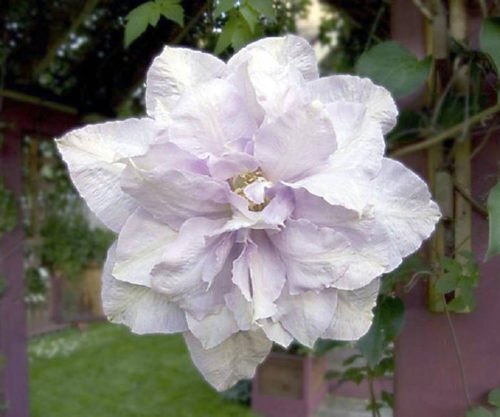


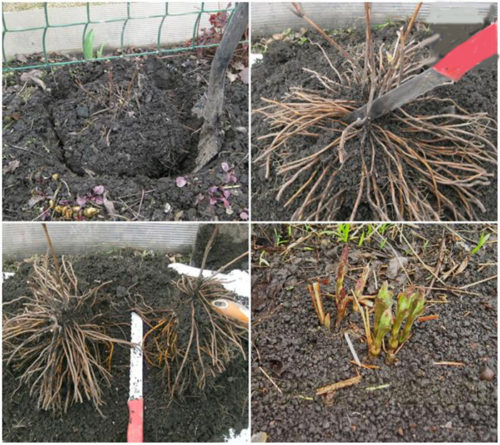


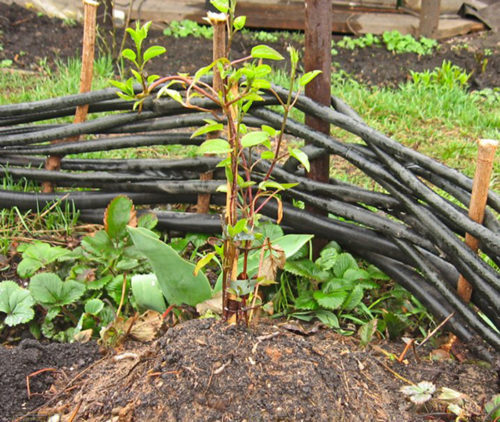
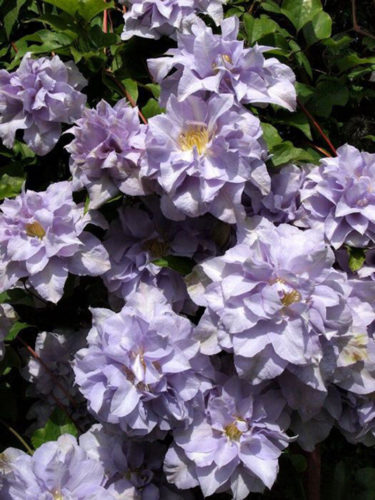


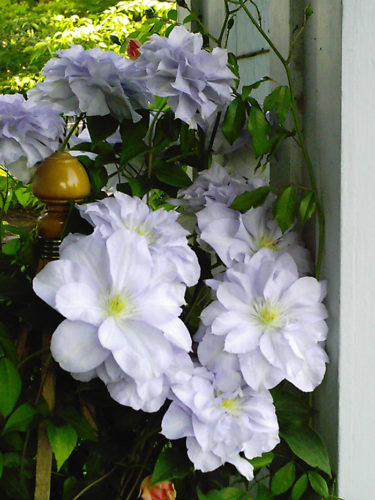












 Start a discussion ...
Start a discussion ...